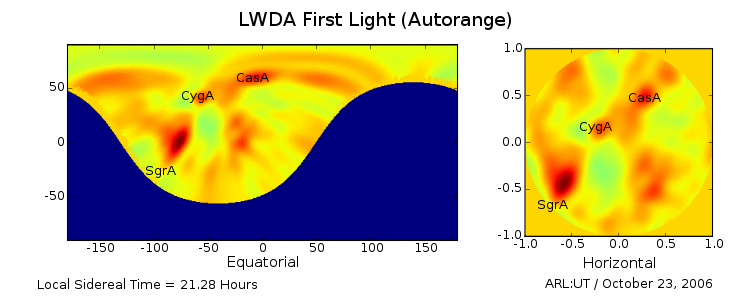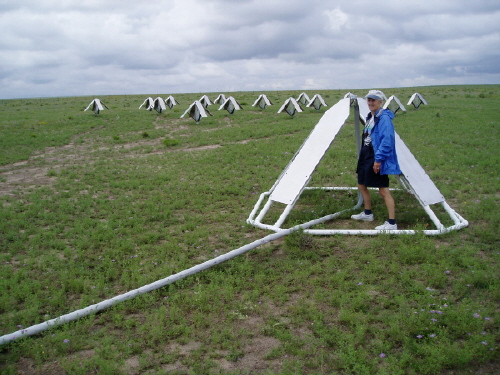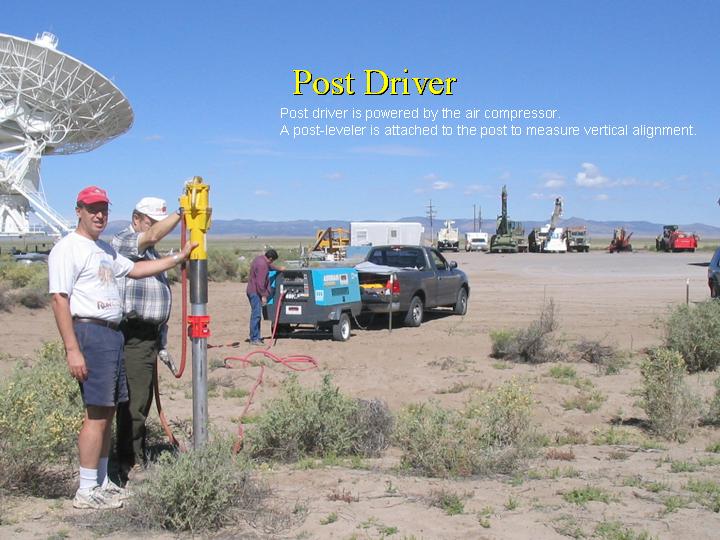News
Long Wavelength Demonstrator Array LWDA
Welcome to the Construction site
The LWDA is a test bed for the development of the LWA - it is located on the VLA site.
LWDA InterferometerDuring the week of May 14, 2007 an LWA team working with Bill Erickson set up an outlier antenna to work with the LWDA as an interferometer. The outlier is the second of the Big Blade antennas currently at the LWDA site (aka BB2) and is located approximately 300 meters due East of the 16 element LWDA. The interferometer allows us to achieve high Signal-to-Noise measurements on many known discrete radio sources. In turn, that allows us to constrain technical characteristics of the LWDA more accurately than previously possible, including accurate flux and phase calibration. The interferometer also brings a new operational mode for targeted source observations, in addition to the current all-sky monitoring and phased array beam-forming modes of the LWDA alone. The LWDA and outlier are remotely configurable between various modes, including with multiple beams, and a number of innovative science programs are being considered to take advantage of these capabilities.

Landscape photo showing the approximate 300 m separation between Big Blade 2 (BB2 - on the left) and the 16 element LWDA (on the right).
SINE and COSINE interferometer fringes on the bright radio source Cas A at 74 MHz. The operational mode employed was a tracking two element interferometer between the outlier Big Blade antenna (BB2) and the phased array LWDA. Each point represents 1 second of data at 1.6 MHz instantaneous bandwidth.
The Specmaster Data website lets you view Daily Dynamic Spectra and learn about special events from Big Blade at the LWDA site.
Commissioning observations made in October 2006 by the Long Wavelength Demonstrator Array (LWDA) highlight its all sky imaging capability. This 24 hour movie (also available in mpg format) is made at a frequency of 73.8 MHz and shows the full sky as visible from the LWDA site in New Mexico. As the sky rotates, emission from the bright sources Cassiopeia A, Cygnus A, and the Sun, as well as the bright regions of the Galactic Plane, are all clearly visible. The Galactic Center region is marked by the position of the Sagittarius A complex. This movie was made by Tracy Clarke (NRL/Interferometrics Inc) using AIPS to process the observations from the LWDA.
During second half of October 2006 all the hardware was installed at the site, including both polarizations and digital receivers for all the dipoles. Careful phase calibrations were performed and these movies demonstrate how successful they were. Congratulations to all who made this possible.
Constructing the LWDA
LWDA site - 16 dipoles and electronics trailer (right back) with VLA antennas in the background as photographed in early August 2006.
New large blade antenna for testing (photo - August 2006).
The first results are displayed in power point presentations at URSI and AAS in January 2006.
Construction of the LWDA began at the VLA site during the Autumn 2005.





